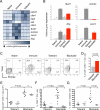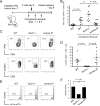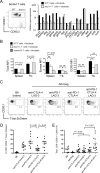Checkpoint blockade immunotherapy relies on T-bet but not Eomes to induce effector function in tumor-infiltrating CD8+ T cells
- PMID: 25516478
- PMCID: PMC4324019
- DOI: 10.1158/2326-6066.CIR-14-0159
Checkpoint blockade immunotherapy relies on T-bet but not Eomes to induce effector function in tumor-infiltrating CD8+ T cells
Abstract
Coinhibitory receptor blockade is a promising strategy to boost T-cell immunity against a variety of human cancers. However, many patients still do not benefit from this treatment, and responders often experience immune-related toxicities. These issues highlight the need for advanced mechanistic understanding to improve patient outcomes and uncover clinically relevant biomarkers of treatment efficacy. However, the T-cell-intrinsic signaling pathways engaged during checkpoint blockade treatment are not well defined, particularly for combination approaches. Using a murine model to study how effector CD8(+) T-cell responses to tumors may be enhanced in a tolerizing environment, we identified a critical role for the T-box transcription factor T-bet. Combination blockade of CTLA-4, PD-1, and LAG-3 induced T-bet expression in responding tumor/self-reactive CD8(+) T cells. Eradication of established leukemia using this immunotherapy regimen depended on T-bet induction, which was required for IFNγ production and cytotoxicity by tumor-infiltrating T cells, and for efficient trafficking to disseminated tumor sites. These data provide new insight into the success of checkpoint blockade for cancer immunotherapy, revealing T-bet as a key transcriptional regulator of tumor-reactive CD8(+) T-cell effector differentiation under otherwise tolerizing conditions.
©2014 American Association for Cancer Research.
Figures




References
-
- Fridman WH, Pages F, Sautes-Fridman C, Galon J. The immune contexture in human tumours: impact on clinical outcome. Nat Rev Cancer. 2012;12:298–306. - PubMed
-
- Schreiber RD, Old LJ, Smyth MJ. Cancer immunoediting: integrating immunity's roles in cancer suppression and promotion. Science. 2011;331:1565–70. - PubMed
-
- Tivol EA, Borriello F, Schweitzer AN, Lynch WP, Bluestone JA, Sharpe AH. Loss of CTLA-4 leads to massive lymphoproliferation and fatal multiorgan tissue destruction, revealing a critical negative regulatory role of CTLA-4. Immunity. 1995;3:541–7. - PubMed
Publication types
MeSH terms
Substances
Grants and funding
LinkOut - more resources
Full Text Sources
Other Literature Sources
Molecular Biology Databases
Research Materials

